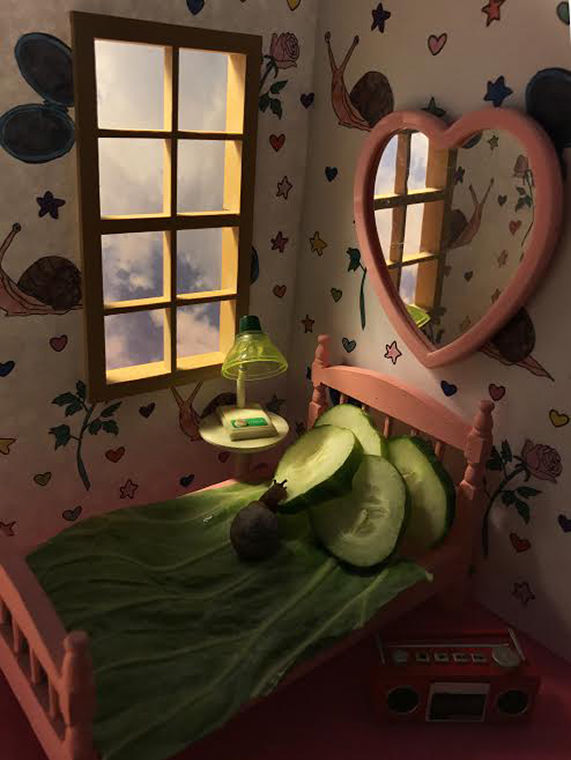Slime meets surreal: artist creates scenery for snails
February 13, 2017
Light pours into a tiny room, revealing a bed covered not with a pillow and sheets, but lettuce and cucumbers. Tucked inside is not a human, not a cat, but a snail.
Chicago artist Aleia Murawski creates miniature rooms, combining furniture, food and snails to make surreal settings. Murawski is a multimedia artist, working with sculpture and photography. She and her roommates also host an “art bnb,” called Soft Center, to work with other artists.
“[Snail art is] a practice where it doesn’t rely on a studio,” Murawski said. “Working really small, I can take [it] everywhere I go.”
Murawski’s snail project was born out of collaboration with artist Samuel Copeland, who owns the snails used for every whimsical environment. One of the surreal miniature settings with which Murawski teases her audience is a purple, moody room, lit thought a window, featuring a snail alongside a toilet and sink just its size.
“It’s my therapy after work to put these collaborations together,” Murawski said. “And we have pet snails, so they add to the space.”
Soft Center co-founder Jill Rahn has known Murawski since their freshman year of college. She said Murawski likes working with snails because they are androgynous and a neutral character to add to her settings.
“Her work is coming from a craft-space, not a domestic space, and [the snails] make them into these unorthodox spaces,” Rahn said.
Murawski said she has been working with miniatures for her whole life. Her art tries to start conversations about everyday life while using objects that are nostalgic for her.
“In a lot of ways, it’s about my narrative, but it’s not explicit,” Murawski said. “Whatever I’m making is in response to daily life.”
Based in Pilsen, their “art bnb” is an old storefront that has been converted into a creative space for gallery openings and pop-up shops. Its goal is for artists to meet likeminded creatives in the city and produce projects they might not have space for otherwise.
“It’s a landing spot for people, and it provides a roof if they’re working here and need somewhere to stay,” said collaborator and local artist Alex Wallbaum.
Rahn said they were inspired by female art movements they saw online, in the community and outside of Chicago.
“It’s finding a new community and finding new artists that need safe and portable spaces,” Rahn said.
Soft Center has an extra bedroom, which they hope will be use to stay and develop their won projects, Murawski said. For the past couple years, Murawski said it has been difficult to meet other artists, so this space allows local or visiting artists to put on a show or workshops.
“We wanted [a name] that refers to our name as a home: a very open space where people feel comfortable and can take on different forms,” Murawski said.








